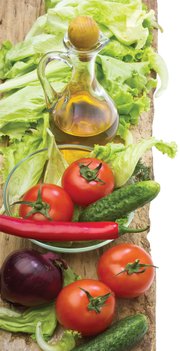Gardening is popular for a number of reasons — it adds beauty in and around the home; it can relieve stress; and it provides control and knowledge of how food is grown.
Not only is there satisfaction in nurturing a seed to fruition, there is a nutritional benefit as well.
“Nothing tastes better than the plants picked directly from your garden and placed on your plate. You have access to a full array of nutrients and you save money, too,” said Judy Paynesmith, owner of Lean Green Cuisine in Fayetteville.
And it certainly isn’t necessary to plow up half — or any — of the backyard to take up gardening. It can be done completely in containers. “A huge benefit of container gardening is there’s no need to clear land because your garden is in a container,” Paynesmith said.
Another advantage is that the gardener has complete control over soil quality. Once the soil is prepared, plants can be cultivated from seed, which is widely available; as a sprout ready to transplant; or purchased potted and fully grown.
A wealth of information about container gardening is available at local plant nurseries or farm supply stores, farmers markets, in books and online. Here is a summary of basics that one should consider when starting a container garden.
What to grow
For rookies and veterans alike, it is important to select the right plants. Mixed herb gardens are a popular choice with beginner growers. Annual herbs such as basil, parsley, cilantro and dill are good companion plants because they tend to grow easily and need similar amounts of water and light. Some pairings, such as tomato and basil, helps enhance the flavor of each plant.
“Herbs in particular like very good drainage, so I tend to use clay pots with lots of holes in the bottom and even mix a little sand into the potting mix,” said Sara Pollard of Mountain Greenery, a vendor at the Fayetteville Farmers Market.
Potted plants can be set on top of blocks or bricks to make sure pools of water don't form underneath when the plant is watered.
"It's important not to over-water,"Pollard said.
Most herbs require only about 6 inches of soil, Pollard said.
Annual herbs thrive for one year and should be pinched off before the plant produces flowers, helping it produce more edible leaves.
"The energy of the plant is put into growing the seed but if you pinch off the tops before it flowers it helps keep the herbs bushy," Pollard said.
Perennial plants such as sage, rosemary, lavender and thyme can be planted once and will grow for many years. Onion chives are another perennial, and these plants grow so easily that they regularly sprout on lawns.
“Perennial plants do best in full sun and when they have a dormant stage, so it is best to plant them in the ground during the cold season,” Pol- lard said.
What to know
The U.S. Department of Agriculture divides North America into 11 separate growing zones, determined by the average winter temperature. Arkansas ranges from 6a-8a with Northwest Arkansas sitting comfortably in Zone 6b. Most seed packets have a chart on the back to aid in optimal planting times, sun, water and wind conditions. If planters are kept outdoors, these parameters should be followed.
Planting in containers provides the benefit of being able to (somewhat) control the affect of the natural environment.
When overnight temperatures drop, the pots can easily be covered or, if lightweight enough, moved indoors temporarily. The plant can also be easier to relocate to adjust the amount of direct sunlight or moisture it is receiving.
Another important benefit to container gardening is being able to determine in what the seed or seedling is grown. The soil in the ground often carries a high amount of clay, which doesn’t benefit most plants. A variety of potting soil is available and ready for plants. Applying fertilizer to feed the plants is necessary to produce healthy plants, especially in container pots with adequate drainage. Most plants will show telltale signs of an imbalance — whether it is too much or too little water, too much or too little sunlight, or not enough nutrients. The trick is finding that balance.
What to use
The container itself can be an important factor to ensuring good growth, but there are far more good containers than bad ones. Bad ones are made of wood that can rot, those that don’t drain well, or ones that are too small to allow root growth. Good ones can be handmade from wood, such as treated pine or cedar. Glazed clay pots, hanging baskets or garden bucket with holes drilled into the bottom are easy to find and make fine planters.
Self-watering containers are a perfect solution for those who have trouble remembering or knowing when to water.
Tower gardens are a growing trend that eliminate the need for soil and only use water and plant food. The tower garden also allows for a variety of plants in a small area and can be purchased locally at Lean Green Cuisine.
The importance of the container, beyond a few basic needs, can be as simple or involved as one wants to make it. For those who want to be creative, unusual items like crocks, old tires or tool boxes can be used. Lining the item with a plastic trash bag can help keep the container sanitary. Get creative will color schemes, both of the plants and the container — and don’t forget the drainage holes.


